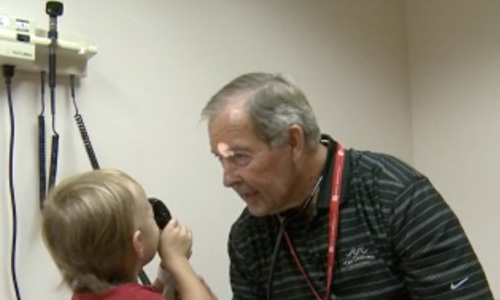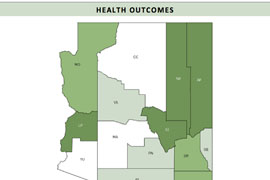Cronkite News has moved to a new home at cronkitenews.azpbs.org. Use this site to search archives from 2011 to May 2015. You can search the new site for current stories.
Gila, Apache continue to lag in latest health ranking of counties
WASHINGTON – Arizona continued to fall well short of national averages on a range of health indicators, from the prevalence of fast-food restaurants to the availability of primary care physicians and the teen birth rate, according to a national health report Tuesday.
The state numbers were drawn from a Robert Wood Johnson Foundation study of more than 3,000 counties that were ranked from healthiest to least healthy in each state. And for the third year in a row, Gila and Apache counties were the worst in the state for health outcomes and heath factors, respectively.
Neither Gila County nor Apache County health officials responded to requests for comment Tuesday. But state health officials said the county statistics, more than statewide numbers, are important because the most effective solutions happen at the local level.
“Their (the ranking’s) purpose is to inform communities to create their own priorities,” said Laura Oxley, spokeswoman for the Arizona Department of Health Services. “The best way to make an intervention is on a very local instance.”
Because Arizona is made up of diverse counties that vary by population and environment, Oxley said, the county-by-county health ranking “allows a better opportunity for action” and gives localities the chance to “talk about the problems they face.”
Gila County‘s last-place standing for health outcomes in Arizona was based on its premature death rates, percentage of low-birthweight babies and reported days of poor physical and mental health. The county’s premature death rates were about 50 percent higher than the state’s.
Gila County’s poor health outcomes came despite the fact that the county ranked in the middle of the pack – ninth among Arizona’s 15 counties – for health factors, or characteristics such as tobacco use, diet and exercise, access to care, income and environment, among others, that affect health.
Apache County was ranked the worst in the state for health factors – a title it has claimed for the past three years. For the past two years, Apache County was also second-worst for health outcomes, according to the report.
The county’s ratio of 2,575 residents for every one primary care physician, 33 percent adult obesity rates and 28 percent adult physical inactivity rates all exceeded the state averages, and all helped contribute to its low rank for county health factors.
But one of the report’s authors cautioned that a county maintaning the same rank over several years does not necessarily indicate a lack of progress.
“Ranking really doesn’t allow you to follow progress as well as you might expect,” said Patrick Remington, a professor and associate dean at the University of Wisconsin School of Medicine and Public Health – a co-producer of the report.
“We use the most recently available data, but for some indicators – they are from almost a decade ago,” he said. “Some of these measures don’t change very quickly.”
While there are limits to the county-by-county data, Remington said, it is still the best option because there is an abundance of localized data that are compiled by many national organizations, which were used to calculate the rankings.
Counties could chose to ignore the findings of the report, because in some instances it uses older data, said Michelle Larkin, assistant vice president for Robert Wood Johnson Foundation. But that would be “ignoring a problem that’s continuing to grow,” she said.
“The rankings make clear that we all have a role to play when it comes to better health for our communities,” Larkin said.










